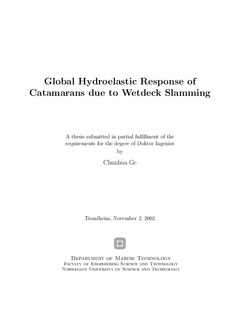| dc.contributor.author | Ge, Chunhua | nb_NO |
| dc.date.accessioned | 2014-12-19T11:24:48Z | |
| dc.date.available | 2014-12-19T11:24:48Z | |
| dc.date.created | 2002-12-19 | nb_NO |
| dc.date.issued | 2002 | nb_NO |
| dc.identifier | 125208 | nb_NO |
| dc.identifier.isbn | 82-471-5518-4 | nb_NO |
| dc.identifier.uri | http://hdl.handle.net/11250/231224 | |
| dc.description.abstract | Global hydroelastic effects due to wetdeck slamming on a catamaran at Froude numbers between 0.30 and 0.33 in regular head waves are studied theoretically and experimentally.
The wetdeck has a horizontal transverse cross-section. The important elastic properties of the experimental model are theoretically accounted for by using small elastic beam elements connecting three rigid bodies. The hydrodynamic loads on the side hulls are based on the strip theory by Salvesen et al. (1970) without hull interaction. The forward speed causes end terms at the forward ends of the second and third body counted from forward perpendicular (FP). A modal based method is used to include heave, pitch, two-node and three-node vertical bending modes.
The three-body theoretical model without wetdeck slamming agrees well with experimental eigenvalues, relative vertical motions at the bow, vertical shear forces and bending moments at two transverse cuts. Mode shapes agree with Finite Element Method (FEM) results. Five analytically based wetdeck slamming models are presented. The structure is locally rigid and the flow due to slamming is two-dimensional in a longitudinal cross-sectional plane. It is shown sufficient from a global response point of view, to use a Von Karman type of method and a linear approximation of the relative impact velocity. The effect of high forward speed on the slamming loads is investigated by modifying the dynamic free surface condition and including a Kutta condition at the aft end of the wetted deck. The flow is mathematically equivalent to the 2D linear unsteady lifting problem of a thin foil in infinite fluid. An important difference is that the wetted length is time dependent. The Kutta condition model may matter. Both the water entry and exit phases during the slamming are important for global response. The theory gives generally good agreement with experimental results for slamming loads and wetdeck slamming induced global vertical shear forces and bending moments at the two transverse cuts. However, there is one slamming case with unsatisfactory agreement. This is believed to be due to the neglection of piston mode resonance of the fluid motion between the two side hulls. Both theory and experiments show a strong influence of two-node bending on global loads. There is also some influence of the three-node bending, but this is not satisfactorily predicted.
An error analysis in the experiments is made for the most severe slamming case. Since the experiments were not done as a part of this thesis and each test condition was done only once, random errors can not be identified. Systematic errors are discussed and error estimates of experimentally predicted vertical shear forces and bending moments are made by extensively using the theoretical model. It is shown that the trim angle is the most important error source. The changing incident wave amplitudes along the track of the model and the wave measurement inaccuracies are equally the second most important error source for vertical bending moment at the two transverse cuts investigated in the experiments. The error associated with roll, yaw and sway is the second most important for vertical shear force at the two cuts. The estimated combined relative errors in experimentally predicted vertical shear forces and bending moments are between 0.17 and 0.29.
Error sources in the theory are also discussed. Since no benchmark theoretical model that properly includes all physical effects exists, we must to some extent rely on experimental results. The discussion covers side hull hydrodynamics and hull interaction, slamming modelling, structural modelling and effect of transient phase. It is shown that hydrodynamic hull interaction may matter.
A future perspective is to develop a numerical method that can predict wetdeck slamming induced global response of multihull vessels in any sea state and at any forward speed. This involves long term statistical description of combined load effects due to both transient slamming induced whipping and steady state linear and nonlinear wave loads. | nb_NO |
| dc.language | eng | nb_NO |
| dc.publisher | Fakultet for ingeniørvitenskap og teknologi | nb_NO |
| dc.relation.ispartofseries | Dr.ingeniøravhandling, 0809-103X; 2002:125 | nb_NO |
| dc.title | Global Hydroelastic Response of Catamarans due to Wetdeck Slamming | nb_NO |
| dc.type | Doctoral thesis | nb_NO |
| dc.source.pagenumber | 190 | nb_NO |
| dc.contributor.department | Norges teknisk-naturvitenskapelige universitet, Fakultet for ingeniørvitenskap og teknologi | nb_NO |
| dc.description.degree | dr.ing. | nb_NO |
| dc.description.degree | dr.ing. | en_GB |
